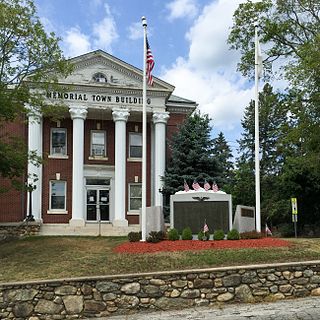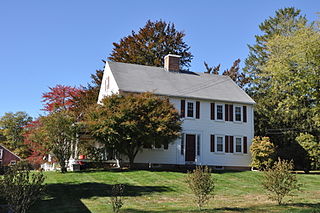
Wakefield is a village in the town of South Kingstown, Rhode Island, United States, and the commercial center of South Kingstown. Together with the village of Peace Dale, it is treated by the U.S. Census as a component of the census-designated place identified as Wakefield-Peacedale, Rhode Island. West Kingston, another South Kingstown village, was the traditional county seat of Washington County. Since 1991, the Washington County Courthouse has been in Wakefield. The Sheriff's Office which handles corrections is also in Wakefield.

Peace Dale is a village in the town of South Kingstown, Rhode Island. Together with the village of Wakefield, it is treated by the U.S. Census as a component of the census-designated place identified as Wakefield-Peacedale, Rhode Island.
George Tibbits was an American politician and a member of the United States House of Representatives from New York. He was born in Warwick, Rhode Island on January 14, 1763. He pursued classical studies and engaged in business in Lansingburgh, New York in 1784. He moved to Troy, New York in 1797 and became engaged in extensive mercantile pursuits. He was a member of the New York State Assembly in 1800.

The Beneficent Congregational Church is a United Church of Christ Congregationalist church located at 300 Weybosset Street in downtown Providence, Rhode Island. The congregation was founded in 1743 during the "First Great Awakening" as a separatist spin-off from a Congregationalist group on the east side of the Providence River, and built their first sanctuary on this site. The current church was built in 1809 and was extensively remodeled in the Greek Revival style in 1836.

Casey Farm is a historic farm in Saunderstown, Rhode Island, United States. It is now a historic museum property, operated by Historic New England, and is open to the public.

Slatersville is a village on the Branch River in the town of North Smithfield, Rhode Island, United States. It includes the Slatersville Historic District, a historic district listed on the National Register of Historic Places. The historic district has been included as part of the Blackstone River Valley National Historical Park. The North Smithfield Public Library is located in Slatersville.

North Uxbridge is a village and a post office in the town (township) of Uxbridge in Worcester County, Massachusetts, United States. The postal zip code is 01538. It is classified as a community or populated place located at latitude 42.088 and longitude -71.641 and the elevation is 266 feet (81 m). North Uxbridge appears on the Uxbridge U.S. Geological Survey Map. Worcester County is in the Eastern time zone and observes DST. North Uxbridge is located about 36 miles WSW of Boston, and 15 miles SE of Worcester. The town meeting in 1885 set aside North Uxbridge as a "special district", since its population had exceeded 1000 people. North Uxbridge appeared to be a separate Census tract in the 1960 census with a population of 1882. In 2013, an Uxbridge DIY show, The Garage, with Steve Butler, went worldwide from Steve's garage in North Uxbridge.

Saylesville is a village and historic district in Lincoln, Rhode Island.

The Amos Cook House is an historic house in Scituate, Rhode Island. Built in 1812, it is a 2+1⁄2-story wood-frame structure, five bays wide, with a large central chimney. The center entry is framed by a Greek Revival surround that was a later alteration, and there is a shed-roof porch extending along the southern (left) facade. The house has retained much of its interior woodwork. The house was built by Augustus and Carver Hopkins, members of Rhode Island's prominent Hopkins family. It was purchased, along with a number of farm outbuildings, by Amos Cook in 1865, and was converted into a summer residence in the early 20th century.

The Edwin H. Farnum House is an historic house at the junction of Putnam Pike and Collins Street in Johnston, Rhode Island. It is a two-story wood frame structure, five bays wide, with a large central chimney. It was built c. 1765, either by Stephen Angell or his son Daniel, and enlarged about 1795 by Edwin Farnum. The main entry exhibits Federal styling probably added by Farnum, with 3/4 length sidelight windows and a segmented fanlight above. The right-side bays on the first floor have been replaced by a 20th-century bay window.

The Allen–Madison House is a historic house on Marine Road in North Kingstown, Rhode Island. It is located on the grounds of the former Davisville Naval Construction Battalion Center, set on an isolated plot apart from the main portion of the base.

The Edward Dexter House is a historic house in the College Hill neighborhood of Providence, Rhode Island. It is a 2+1⁄2-story wood-frame structure, built in 1795–1797, with a hip roof topped by a square monitor. Its main facade is five bays wide, with the center bay flanked by two-story pilasters and topped by a small gable pediment. The well-preserved interior provided a template for an early-20th-century museum space designed by the Rhode Island School of Design to house a furniture collection donated by the house's then-owner, Charles Pendleton. The house is one of the few 18th-century houses in the city's College Hill neighborhood. It was originally located at the corner of George and Prospect Streets; in 1860 it was sawed in half and moved in sections to its present location.

The First Universalist Church is a historic church at 250 Washington Street in Providence, Rhode Island.

The Plain Farm House is an historic house in Providence, Rhode Island. It is a 2+1⁄2-story wood-frame structure, five bays wide, with a central entry flanked by sidelight windows and topped by a semi-elliptical fan. The house was probably built in the early 19th century, based on its Federal styling, and on the opening of the nearby Norwick Pike in 1803. At the time of its construction the area was part of Johnston, and was annexed to Providence in 1898. Once the main house of a large farm, it is now surrounded by residential development.

The Washington Park Sewage Pumping Station is an historic wastewater pumping facility in Providence, Rhode Island. Its principal visible component is a concrete block structure, finished in stucco and topped by a hip roof, which is about 16 by 16 feet. This building stands atop a large cast-in-place concrete well, in which pumps and gate valves are housed. The facility was built in 1911 to pump raw sewage from the low-lying Washington Park area to the Field's Point wastewater treatment facility, which lies about 1,000 feet (300 m) to the north. The pump station is located well back from the street, behind a low brick distribution facility. It was added to the National Register of Historic Places in 1989.

The Kent County Courthouse, now the East Greenwich Town Hall, is a historic court building at 127 Main Street in East Greenwich, Rhode Island.

The Rice City Historic District is a historic district in Coventry, Rhode Island. It encompasses the 19th-century village of Rice City, extending along Plainfield Pike for several miles between Sisson Road and Gibson Hill Road in the northwestern part of Coventry. The main village center is at the junction of the Pike and Vaughn Hollow Road, and there is a former industrial and commercial center at Fairbank's Corner, the junction with Flat River Road. The architecture of the district is predominantly rural and residential, with Greek Revival and Federal style housing predominating. Rice City village is dominated by Rice Tavern, which used to serve travelers on their way to Connecticut, as well as the Rice City Church (1846), the Democrat Schoolhouse, and the Obadiah Potter House (1846), all a short way up Vaughn Hill Road. At the western edge of the district, the modern Pike alignment diverges from the historical one at Gibson Hill Road, where the foundational remnants of agricultural settlements may be found.

The John R. Waterman House is an historic house at 100 Old Homestead Road in Warwick, Rhode Island. The 2-1/2 story wood frame house was built c. 1800 by John R. Waterman, a prominent local farmer and politician. Waterman played a significant role in what became known as Dorr's Rebellion, an ultimately successful attempt to force liberalizing changes to the state constitution. The house is an excellent local example of Federal style, and is locally distinct for its use of paired interior chimneys instead of a large central one.

Fort Hill Historic District is a historic district roughly on South Street between Lyman to Monroe in Northampton, Massachusetts.
Clapp House may refer to:




















